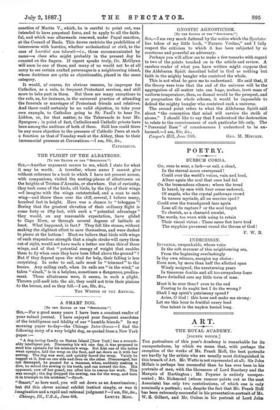THE FLIGHT OF THE ALBATROSS.
ITO THE EDITOR Or ins ERECTAT0101 Sra,—Another argument occurs to me, which I state for what it may be worth. A traveller, whose name I cannot give without reference to a book to which I have not present access, with companions, visited the nesting-planes of albatrosses on the heights of Tristan d'Acunha, or elsewhere. Out of curiosity, 'they took some of the birds, old birds, by the tips of their wings —I imagine with the wings outstretched, and a man to each wing—and threw them over the cliff, several, I believe many, hundred feet in height. Here was a chance to " toboggan"! Seeing that the greatest elevation of their ordinary flight is some forty or fifty feet, with such a "potential advantage" 'they would, on any reasonable expectation, have glided to Cape Horn, or through several degrees of latitude at least. What happened, in fact ? They fell like stones, without making the slightest effort to save themselves, and were dashed to pieces at the bottom ! Must we believe that birds with wings of such stupendous strength that a single stroke will carry them out of sight, would not have made a better use than this of those wings, and of that " potential energy of weight that enables them to fly when once they have been lifted above the ground" ? But if they depend upon the wind for help, their falling is lees surprising. In order to sail, sails must be " trimmed " to the breeze. Any sailing craft, when its sails are " in the wind," or taken "aback," is in a helpless, sometimes a dangerous, predica- ment. These albatrosses were, it seems, in such a plight. "Thrown pell-mell into the air, they could not trim their pinions 'to the breeze, and so they fell.—I am, Sir, &c.,
THE WRITER Os THE ARTICLE.


































 Previous page
Previous page